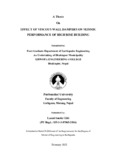Please use this identifier to cite or link to this item:
https://elibrary.khec.edu.np:8080/handle/123456789/510| Title: | EFFECT OF VISCOUS WALL DAMPERS ON SEISMIC PERFORMANCE OF HIGH RISE BUILDING |
| Authors: | Libi, Laxmi Sunder |
| Advisor: | DR. CHANDRA KIRAN KAWAN, DR. MANJIP SHAKYA |
| Keywords: | Viscous wall damper, mid rise building, High rise building, Base reaction, Drift, Non linear time history analysis, Fast nonlinear analysis, demand capacity ratio. |
| Issue Date: | Feb-2023 |
| College Name: | Khwopa Engineering College |
| Level: | Masters |
| Degree: | ME Earthquake |
| Abstract: | Strong Ground motion causes lateral displacement in the buildings which resulted massive damage and loss of life and property. High rise buildings are such buildings whose design and analysis need special care and rigorous analysis to make them earthquake resistant. Because of variation in sediment depth and its properties within a short distance in the Kathmandu valley, the earthquake vulnerability of the high rise building is very high. The practice of performance based design using seismic energy dissipating devices such as Viscous Wall Dampers in tall building is common in many developed and developing countries however it is rare in the case of Nepal. In this study 3D Non-linear Time History Analysis using ETABS V20 is applied for the seismic performance analysis considering code prescribed earthquake ground motion. Viscous wall dampers were used uniformly distributed with equal damping force to full height of the building along four sides of the building. An attempt is made to capture the comparative behavior of the structure by explicitly modeling of viscous wall damper and bare frame modeling to study the comparative responses of 5 storey, 7 storey, 10 storey and 15 storey model. From the analysis, it is found that about 35-40% of total base reaction is reduced with the use of viscous Wall damper in 7 storey and 10 storey building and about 30% is reduced in 15 storey building model and for 5 storey model base reaction in reduced by 25%. Inter storey drift percentage is reduced from 40%-45% varied at different storey level for 7 storey model and for 10 storey drift is reduced by approx. 35% and for 5 storey and 15 storey building drift is reduced by 20-25%. Internal stresses like bending moment in column due to lateral load reduced by 50% for 7 storey model and for 10 storey model moment is reduced by approx. 40% also for 5 storey and 15 storey building it is reduced by 30%. Demand capacity ratio for ground floor column is found reduced by 40% in average for 7 and 10 storey building and for 5 storey and 15 storey building demand capacity ratio is reduced by 30%. In conclusion, according to result of base reaction, displacement, drift and other performance parameter, it is observed that responses in mid rise building with viscous wall damper has been reduced significantly and the performance of high rise building is also significantly reduced. |
| URI: | https://elibrary.khec.edu.np/handle/123456789/510 |
| Appears in Collections: | Master of Science (M.Sc) in Earthquake engineering |
Files in This Item:
| File | Description | Size | Format | |
|---|---|---|---|---|
| Laxmi Sunder Libi.pdf Restricted Access | 5.3 MB | Adobe PDF |  View/Open Request a copy |
Items in DSpace are protected by copyright, with all rights reserved, unless otherwise indicated.
